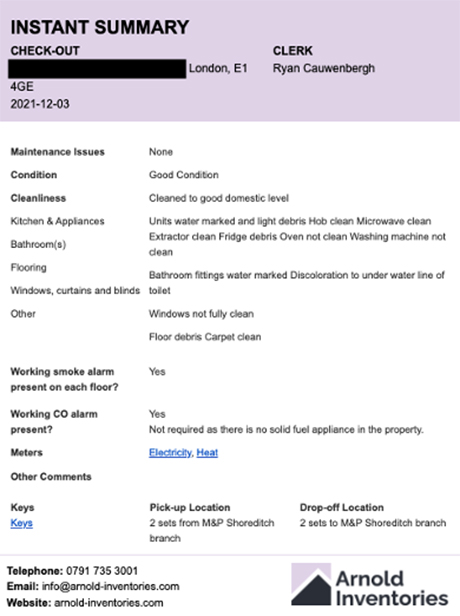A periodic tenancy is a type of tenancy agreement with no fixed term attached, sometimes referred to as a rolling contract, and allows both tenants and landlords a great deal of flexibility when it comes to vacating a premises for a number of reasons. These types of tenancy agreements can be beneficial to both parties, depending on individual circumstances.
For instance, a tenant whose job may require them to work in different locations frequently and with little notice can benefit from a periodic or short term tenancy agreement, as they are usually only required to give 1 month’s notice before vacating a premises. This type of agreement can also help landlords attract prospective tenants who may not wish to be tied down to a single property for long periods of time.
In this blog post from Arnold Inventories, we explain how periodic tenancy agreements work, including the benefits and disadvantages of such an agreement.

How Do Periodic Tenancy Agreements Work?
Periodic tenancy agreements offer more freedom than a traditional fixed-term contract, and can refer to payment periods that are either month-to-month or week-to-week. For instance, if a tenant pays their rent monthly, then this would be a monthly rolling contract.
With a standard fixed term contract, it is usually required that a tenant must continue to pay rent and is responsible for utilities until the end of the contract period, whereas in a periodic or short-term contract the tenant can choose to continue paying rent month-on-month for as long as they want to stay at a property, or until they or the landlord gives notice that they are leaving.
Although a periodic tenancy can also be referred to as a short term tenancy, it is not always the case that a periodic tenancy can only last for a short amount of time, in fact, many tenants on a periodic tenancy will continue to rent a property for a number of years.
Periodic tenancies can occur in any type of rented accommodation, whether you rent an entire property for yourself, a single room, or you live in an HMO (Houses in Multiple Occupation) property in which three or more tenants sharing a kitchen, bathroom and toilet form more than one household.
Can You Break a Periodic Tenancy Agreement?
The benefit of a periodic tenancy agreement for both landlords and tenants is that you can simply speak to the relevant party to inform them that you will be ending the periodic tenancy on a specific date. There may need to be some flexibility involved, particularly for landlords informing tenants they wish to end their contract, as the tenant may require more time to fully vacate the premises.
For landlords moving a tenant out on a periodic tenancy agreement, it can be beneficial to conduct an inventory check out to ensure there has been no damage to the property or its contents.
How Much Notice Does a Tenant Have to Give on a Periodic Tenancy?
The amount of notice you should give as a tenant on a periodic tenancy agreement is relative to the time between your payment periods. For example, if you pay your rent month-on-month, then you should provide at least 1 month’s notice to your landlord, whereas if you pay your rent every 3 months you should provide 3 months’ notice.
How Much Notice Does a Landlord Have to Give on a Periodic Tenancy?
As a landlord, you must give your tenants at least 2 month’s notice on a periodic or short-term tenancy agreement. This is outlined in Section 21 of the UK Government’s laws on evicting tenants in England, to ensure that they are given an appropriate amount of time to find new accommodation if they were previously unaware that their tenancy was about to end; regardless of the fact they are on a rolling contract with no fixed term.
What are the Advantages and Disadvantages of a Periodic Tenancy?
There are a number of benefits and drawbacks to examine for both landlords and tenants when considering a periodic tenancy agreement. These are as follows:
Advantages of a Periodic Tenancy for Landlords
1. Flexibility
There may be circumstances where you need to regain access to your property for a number of reasons. In this instance you can give your tenant 2 months notice to leave the premises, rather than having to wait for a fixed term contract period to end.
2. Tenants may prefer a rolling contract
As mentioned above, some tenants may prefer the flexibility of a periodic tenancy due to work or family commitments. Advertising your property as featuring a periodic tenancy agreement may attract more prospective tenants, and help to fill it or your empty room quicker.
3. Rent increases
There may be instances where you need to increase the rent on your property, for instance if your tenancy agreements are inclusive of bills and prices have increased since the tenancy began. If you need to increase your rent then it is much easier to renegotiate the terms of a rolling contract than those of a fixed-term contract.
4. Reduced letting agent fees
With a periodic tenancy agreement there will be less fees attached for renewals and administration costs incurred through letting agents.
5. Tenant evictions with an assured shorthold tenancy agreement
In certain circumstances, you may need to evict a tenant on short notice if they have not adhered to the terms of your contract, such as through missed rent payments or damages to the property discovered following a mid-term inspection. In this instance you will be able to evict a tenant with less notice than that of a tenant on a fixed-term contract, without having to involve third parties to justify your decision to evict.
Read more about Landlord Inspections in our blog post.
Disadvantages of a Periodic Tenancy for Landlords
1. Less stability
Periodic tenancies don’t provide much stability for either landlord or tenant. In a periodic tenancy, a tenant has the right to give only 1 month’s notice before terminating a contract, which might not provide you with enough time to fill the vacancy before the tenant exits. This may result in a loss of earnings once the tenant has left if the room or property goes unoccupied, not just because of the loss of rent, but you will also be liable to pay bills and council tax for the missing tenant.
2. Increased advertising costs
Similarly, as opposed to a fixed-term contract lasting for 1 year, for example, you will only need to advertise your property once a year if the tenant decides to leave. With a rolling tenancy agreement you may need to pay to advertise your property multiple times within a year if there is a frequent tenancy turnover.
Considerations for a Periodic Tenancy
Provided they are handled correctly, periodic tenancies can be a great way to attract tenants to your property, as well as provide flexibility for a number of reasons. You should expect that your property will go through multiple tenants in a shorter period of time than properties that use a traditional fixed-term contract; as such, it is best to have the correct processes in place to ensure a smooth transition between tenants.
This includes:
- Make sure you are not liable for any missed council tax payments by writing this into your periodic tenancy contract should a tenant leave early.
- Make sure you have the correct processes in place to conduct the following:
Contact Arnold Inventories to Streamline Your Tenancy Processes
Protect your property with a comprehensive inventory report to make sure your tenants are liable for any damage or theft when exiting your property. For month to month rental agreements such as periodic tenancy, this is particularly important as your property will house multiple tenants in a shorter period of time than regular properties.
Contact our expert team today to discover how we can help protect your property today.




0 Comments
Leave A Comment